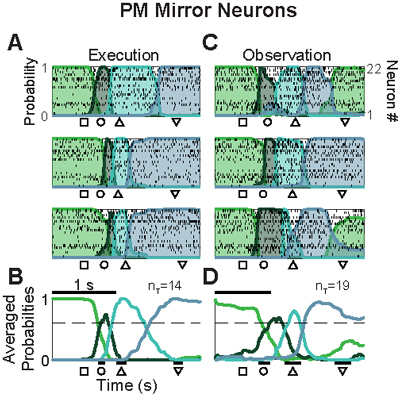URMC / Labs / Schieber Lab / Projects / Observation of Performance: Mirror Neurons
Observation of Performance: Mirror Neurons
Mirror neurons—those that discharge both when a subject performs and action and when the same subject observes the same action being performed by another individual—have been thought to play a role in understanding the actions of other individuals. Whereas others have studied the activity of mirror neurons during movements per se, we recently found that populations of mirror neurons represent multiple preceding and following behavioral epochs during which no movement actually occurs (see publication in J. Neuroscience). We now are examining whether mirror neuron activity is affected by communication between the performer and the observer, whether mirror neuron populations represent instructed delay periods, and whether different components of activity in mirror neuron populations can be dissociated.

A population of 22 pre-motor cortex mirror neurons was recorded simultaneously. A Hidden Markov Model of activity recorded during behavioral trials that involved grasping and rotating a sphere revealed that this population of mirror neurons progressed through four states. These states represented not only the movement epoch (cyan), but also three states during which no movement occurred: the initial hold (green), reaction (dark gray), and final hold (light gray) epochs. Moreover, the model trained on Execution trials (A, B) decoded these four states from data recorded during Observation trials (C, D) as well. For Execution and for Observation, three single trials are illustrated above (A, C) and an average across multiple (nT) trials below (B, D).